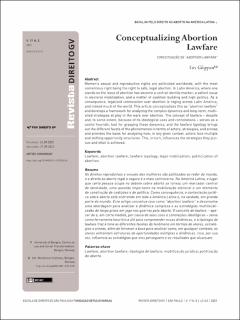| dc.contributor.author | Gloppen, Siri | |
| dc.date.accessioned | 2022-01-28T09:39:09Z | |
| dc.date.available | 2022-01-28T09:39:09Z | |
| dc.date.created | 2022-01-12T00:20:40Z | |
| dc.date.issued | 2021 | |
| dc.identifier.issn | 1808-2432 | |
| dc.identifier.uri | https://hdl.handle.net/11250/2931198 | |
| dc.description.abstract | Women's sexual and reproductive rights are politicized worldwide, with the most contentious right being the right to safe, legal abortion. In Latin America, where one stands on the issue of abortion has become a central identity marker; a salient issue in electoral mobilization, and a matter of coalition building and high politics. As a consequence, legalized contestation over abortion is raging across Latin America, and indeed much of the world. This article conceptualizes this as “abortion lawfare” and develops a framework for analyzing the complex dynamics and long-term, multi-sited strategies at play in the wars over abortion. The concept of lawfare – despite and, to some extent, because of its ideological uses and connotations – serves as a useful heuristic tool for grasping these dynamics, and the lawfare typology brings out the different facets of the phenomenon in terms of actors, strategies, and arenas and provides the basis for analyzing how, in any given context, actors face multiple and shifting opportunity structures. This, in turn, influences the strategies they pursue and what is achieved. | en_US |
| dc.language.iso | eng | en_US |
| dc.publisher | Fundação Getúlio Vargas Escola de Direito | en_US |
| dc.relation.uri | https://www.scielo.br/j/rdgv/a/7CV9SGHgDphL6L9TFTN6S8q/ | |
| dc.rights | Navngivelse-Ikkekommersiell 4.0 Internasjonal | * |
| dc.rights.uri | http://creativecommons.org/licenses/by-nc/4.0/deed.no | * |
| dc.subject | Lawfare | en_US |
| dc.subject | Lawfare | en_US |
| dc.subject | Abort | en_US |
| dc.subject | Abortion | en_US |
| dc.subject | Rettsmobilisering | en_US |
| dc.subject | Legal mobilization | en_US |
| dc.subject | Domstoler | en_US |
| dc.subject | Courts | en_US |
| dc.title | Conceptualizing Abortion Lawfare | en_US |
| dc.title.alternative | Conceituação de "Abortion Lawfare" | en_US |
| dc.type | Journal article | en_US |
| dc.type | Peer reviewed | en_US |
| dc.description.version | publishedVersion | en_US |
| dc.source.articlenumber | e2143 | en_US |
| cristin.ispublished | true | |
| cristin.fulltext | original | |
| cristin.qualitycode | 1 | |
| dc.identifier.doi | https://doi.org/10.1590/2317-6172202143 | |
| dc.identifier.cristin | 1978943 | |
| dc.source.journal | Direito GV Law Review | en_US |
| dc.relation.project | Norges forskningsråd: 248159 | en_US |
| dc.relation.project | Norges forskningsråd: 230839 | en_US |
| dc.subject.nsi | VDP::Statsvitenskap og organisasjonsteori: 240 | en_US |
| dc.subject.nsi | VDP::Political science and organisational theory: 240 | en_US |
| dc.identifier.citation | Direito GV Law Review. 2021, 17 (3), e2143. | en_US |
| dc.source.volume | 17 | en_US |
| dc.source.issue | 3 | en_US |

